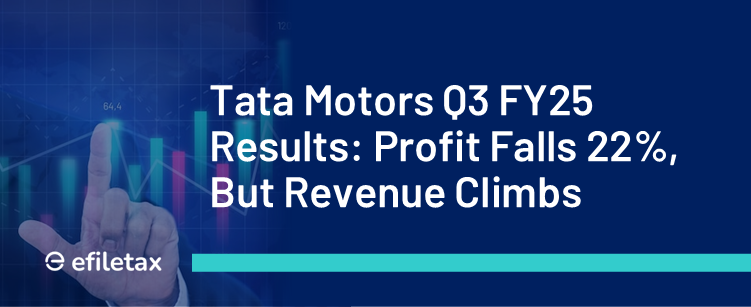
Tata Motors Q3 FY25 Financial Results: Mixed Performance with Profit Decline and Revenue Growth
Tata Motors announced its financial results for the third quarter (Q3) of fiscal year 2025, ending December 31, 2024. The report highlights a 22% year-on-year (YoY) drop in net profit, while revenue registered a 2.7% increase. Here’s a closer look at the performance:
Key Financial Highlights
| Financial Metric | Q3 FY25 | Q3 FY24 | YoY Change |
|---|---|---|---|
| Net Profit | ₹5,451 crore | ₹7,025 crore | ↓ 22% |
| Revenue | ₹113,575 crore | ₹110,577 crore | ↑ 2.7% |
| EBITDA | ₹13,081 crore | ₹15,418 crore | ↓ 15% |
| EBITDA Margin | 11.5% | 13.9% | ↓ 240 bps |
Segment-Wise Performance
1. Commercial Vehicles (CV):
- Revenue declined due to lower volumes.
- EBITDA margins improved owing to cost-saving measures and Production Linked Incentive (PLI) benefits.
2. Passenger Vehicles (PV):
- Revenue dropped by 4.3% YoY.
- EBITDA margin rose by 120 basis points to 7.8%, driven by cost control and PLI incentives.
3. Jaguar Land Rover (JLR):
- Achieved its highest EBIT margin in a decade.
- Q3 revenue increased 1.5% YoY to £7.5 billion.
- New launches, including Defender OCTA and the upcoming Range Rover Electric, boosted brand positioning.
Market Outlook
Tata Motors remains optimistic about future growth, expecting demand to rise in Q4 FY25 due to:
- Government infrastructure spending
- New product launches
- Stable interest rates supporting consumer demand
- Improved commercial vehicle sales
Stock Market Reaction
Despite an optimistic outlook, Tata Motors’ shares dipped by 3% post-results, reflecting investor concerns over mixed performance.
Conclusion
Tata Motors faces profitability challenges amid revenue growth. While cost pressures impact margins, strategic investments in premium vehicles, cost optimization, and government incentives may support long-term stability. The company’s resilience in leveraging product innovation and operational efficiencies will be crucial in sustaining growth amid market fluctuations.